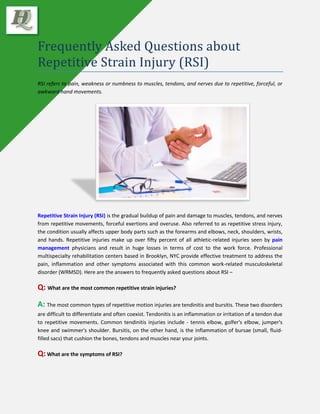Frequently Asked Questions about Repetitive Strain Injury (RSI)
- 1. Frequently Asked Questions about Repetitive Strain Injury (RSI) RSI refers to pain, weakness or numbness to muscles, tendons, and nerves due to repetitive, forceful, or awkward hand movements. Repetitive Strain Injury (RSI) is the gradual buildup of pain and damage to muscles, tendons, and nerves from repetitive movements, forceful exertions and overuse. Also referred to as repetitive stress injury, the condition usually affects upper body parts such as the forearms and elbows, neck, shoulders, wrists, and hands. Repetitive injuries make up over fifty percent of all athletic-related injuries seen by pain management physicians and result in huge losses in terms of cost to the work force. Professional multispecialty rehabilitation centers based in Brooklyn, NYC provide effective treatment to address the pain, inflammation and other symptoms associated with this common work-related musculoskeletal disorder (WRMSD). Here are the answers to frequently asked questions about RSI – Q: What are the most common repetitive strain injuries? A: The most common types of repetitive motion injuries are tendinitis and bursitis. These two disorders are difficult to differentiate and often coexist. Tendonitis is an inflammation or irritation of a tendon due to repetitive movements. Common tendinitis injuries include - tennis elbow, golfer's elbow, jumper's knee and swimmer's shoulder. Bursitis, on the other hand, is the inflammation of bursae (small, fluid- filled sacs) that cushion the bones, tendons and muscles near your joints. Q: What are the symptoms of RSI?
- 2. A: Symptoms can range from mild to severe, beginning gradually and then becoming constant and more intense. Typical signs of RSI include sudden, sharp pain; weakness in the hands or forearms; tingling numbness and tremors (especially in the hand or arm); fatigue or loss of strength; loss of sensation; sensitivity to cold or heat, and a throbbing or pulsating sensation in the affected area. Previous injuries or conditions like rotator cuff tear or an injury to the wrist, back, or shoulder can also predispose you to RSI. Q: What are the causes and risk factors for RSI? A: RSI usually affects those who engage in repetitive movements. These movements can make your muscles and tendons get damaged over time. Some activities that can increase your risk of RSI include - stressing the same muscles through repetition, maintaining poor/abnormal posture for extended periods of time, lifting heavy objects, using a computer more than two to four hours a day, not taking frequent breaks between activities and engaging in continuous desk jobs. Q: How soon should I seek treatment if I suspect RSI? A: If you are experiencing mild discomfort and dysfunction, modifying the type and level of activities or work techniques may help reduce further injury. If chronic pain and loss of function limit your level of activity, seek medical help immediately. As RSI is usually very receptive to treatment in its early stages, getting medical can help you proactively manage the condition. Q: How is RSI diagnosed? A: Diagnosis of this overuse injury will begin with a detailed physical examination. Tests will be recommended to check the affected area for tenderness, inflammation, reflexes and strength. Patients will be asked about their work and other activities to identify any repetitive movements they perform. Diagnostic imaging tests such as magnetic resonance imaging (MRI), ultrasound and electromyography (EMG) may be performed to identify any tissue or nerve damage. Reliable healthcare centers adopt a team approach, with pain management doctors and orthopedic and rehabilitation specialists collaborating to diagnose and treat musculoskeletal injuries. Q: What are the treatment options for RSI? A: Treatment for RSI involves a combination of modalities to address pain, inflammation and muscle spasm. Commonly used treatment options include – physical therapy, Corticosteroid injections, non- steroidal anti-inflammatory medications and Transcutaneous Electrical Nerve Stimulation (TENS). Physical therapy includes therapeutic exercise programs such as strengthening, stretching, aerobic and isometric exercises that help reduce pain, build muscle strength and improve range of motion. Anti- inflammatory painkillers (such as aspirin or ibuprofen), muscle relaxants, and antidepressants may also
- 3. help reduce pain. Another strategy is TENS, which involves administering low electrical simulation that interacts with the sensory nervous system to decrease muscle stiffness and pain. Q: How can RSI be prevented? A: Taking adequate amount of rest and minimizing the intensity of activities that make pain worse may help reduce RSI symptoms in the long run. Modify your work routine in such a way to minimize pain and damage. Try not to engage in repetitive/forceful motions, exert additional pressure or weight on your tendons or muscles. Also, maintain a good posture, take regular breaks during work, do stretching exercises in between and use proper techniques for typing, writing, lifting and other related tasks. www.hqbk.com



